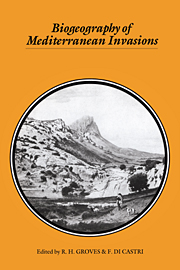Book contents
- Frontmatter
- Contents
- List of contributors
- Preface
- Part I Introduction
- 1 An ecological overview of the five regions of the world with a mediterranean climate
- Part II Historical background
- Part III Biogeography of taxa
- Part IV Applied aspects of mediterranean invasions
- Part V Overview
- Index of scientific names
- Subject index
1 - An ecological overview of the five regions of the world with a mediterranean climate
Published online by Cambridge University Press: 02 December 2009
- Frontmatter
- Contents
- List of contributors
- Preface
- Part I Introduction
- 1 An ecological overview of the five regions of the world with a mediterranean climate
- Part II Historical background
- Part III Biogeography of taxa
- Part IV Applied aspects of mediterranean invasions
- Part V Overview
- Index of scientific names
- Subject index
Summary
The five regions of the world with a mediterranean-type climate, i.e. parts of the Mediterranean Basin, California, central Chile, southern Africa and southwestern and southern Australia, are situated between parallels 30° to 40° North and South. A mediterranean climate can be very broadly defined as a transitional regime between temperate and dry tropical climates, with a concentration of rainfall in winter and the occurrence of a summer drought of variable length (di Castri, 1981). It is a ‘young’ climate, firmly established only in the Pleistocene (Axelrod, 1973).
In these five regions of mediterranean climate, the vegetation is characterised by the dominance of woody shrubs with evergreen leaves that are broad and small, stiff and sticky (sclerophyllous). An overstorey of small trees may sometimes be present as well as an understorey of annuals and herbaceous perennials. This vegetation type is usually called ‘maquis’ in France, ‘chaparral’ in California, ‘matorral’ in Chile, ‘fynbos’ in South Africa and ‘heath’ or ‘mallee’ in Australia (di Castri, 1981).
Over the last 20 years there has been an unprecedented amount of research on the biota and ecosystems of the five regions of mediterranean climate. Mooney (1984) and di Castri et al. (1988a) outlined the main aspects of this particularly productive ‘inter-mediterranean’ research. Co-operation has been achieved because of a mixture of spontaneous collaborative research and several more structured scientific programs.
- Type
- Chapter
- Information
- Biogeography of Mediterranean Invasions , pp. 3 - 16Publisher: Cambridge University PressPrint publication year: 1991
- 38
- Cited by

